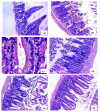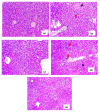Polyphenolic Profile of Herniaria hemistemon Aerial Parts Extract and Assessment of Its Anti-Cryptosporidiosis in a Murine Model: In Silico Supported In Vivo Study
- PMID: 36839737
- PMCID: PMC9964224
- DOI: 10.3390/pharmaceutics15020415
Polyphenolic Profile of Herniaria hemistemon Aerial Parts Extract and Assessment of Its Anti-Cryptosporidiosis in a Murine Model: In Silico Supported In Vivo Study
Abstract
Herniaria hemistemon J.Gay is widely used in folk medicine to treat hernia. The present study aimed to annotate the phytoconstituents of H. hemistemon aerial-part extract and investigate its in vivo anticryptosporidial activity. The chemical characterization was achieved via the LC-ESI-MS/MS technique resulting in the annotation of 37 phytocompounds comprising flavonoids and phenolic acids. Regarding the anticryptosporidial activity, fifty dexamethasone-immunosuppressed mice were separated into five groups: GI, un-infected (normal control); GII, infected but not treated (model); GIII, infected and received NTZ, the reference drug; GIV, infected and received H. hemistemon extract (100 mg/kg); and GV, infected and received H. hemistemon extract (200 mg/kg). When GIII, GIV, and GV were compared to GII, parasitological analyses displayed highly significant differences in the mean numbers of Cryptosporidium parvum oocysts in the stool between the different groups. GV demonstrated the highest efficacy of 79%. Histopathological analyses displayed improvement in the small intestine and liver pathology in the treated groups (GIII, IV, and V) related to the model (GII), with GV showing the highest efficacy. Moreover, the docking-based study tentatively highlighted the potential of benzoic acid derivatives as lactate dehydrogenase inhibitors. The docked compounds showed the same binding interactions as oxamic acid, where they established H-bond interactions with ARG-109, ASN-140, ASP-168, ARG-171, and HIS-195. To sum up, H. hemistemon is a promising natural therapeutic agent for cryptosporidiosis.
Keywords: Herniaria hemistemon J.Gay; LC–ESI–MS/MS; anticryptosporidiosis; lactate dehydrogenase inhibitors; nitazoxanide; polyphenols.
Conflict of interest statement
The authors declare no conflict of interest.
Figures





References
-
- Guk S.-M., Seo M., Park Y.-K., Oh M.-D., Choe K.-W., Kim J.-L., Choi M.-H., Hong S.-T., Chai J.-Y. Parasitic Infections in HIV-Infected Patients Who Visited Seoul National University Hospital during the Period 1995–2003. Korean J. Parasitol. 2005;43:1. doi: 10.3347/kjp.2005.43.1.1. - DOI - PMC - PubMed
LinkOut - more resources
Full Text Sources

